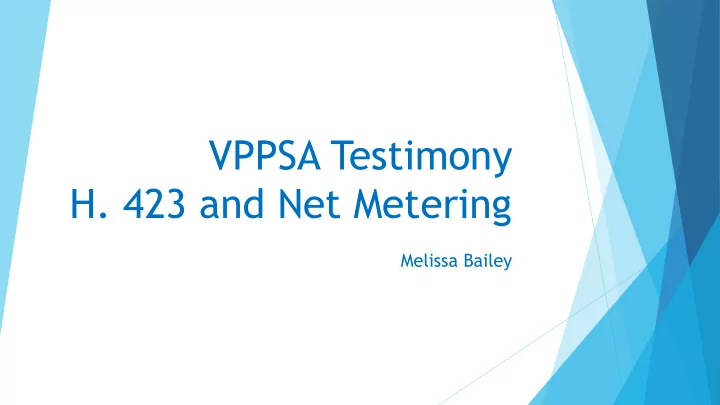

VPPSA Testimony H. 423 and Net Metering Melissa Bailey
VPPSA Net Metering Position VPPSA members are actively engaged in deploying renewable resources and meeting State energy goals. Local, non-profit utilities Committed to values of local decision-making and fairness among ratepayers. PUC carefully balanced costs and benefits in developing current Net Metering rule between 2015 and 2017. Concluded that rates were too high and need to be reduced over time. VPPSA cautions against opening up portions of the NM rule.
Section 8010 Criteria for Net Metering Rules ( A) Advance VT’s renewable goals and total renewables targets (B) Achieve deployment consistent with Energy Plan unless PUC determines energy plan is inconsistent with goals in (A) (C) To extent feasible, ensure no cost shifting in each retail electricity provider’s revenue requirement (D) Account for all costs and benefits of net metering, including T&D and potential to reduce consumption of fossil fuels (E) Ensure all customers who want to participate in net metering have the opportunity (F) Balance, over time, pace of deployment and cost of program with impact on rates (G) Account for changes over time in the cost of technology (H) allows a customer to retain ownership of RECs but: Reduces the credit to the customer if they elect to retain the RECs • Requires utilities to retire net metering RECs that are transferred for RES •
Net Metering in the Context of Vermont’s Renewable Policies The Renewable Energy Standard (RES) will dictate how much small, renewable generation is developed in VT . The Comprehensive Energy Plan (CEP) states: “[p] ower supply questions now revolve around the most cost-effective way to meet the RES requirements, not around how much renewable energy to acquire.” The (CEP) recommends planning: “carefully to meet all three tiers of the RES in a least -cost manner” and to “strive to lower both energy bills and electric rates.”
H. 423 Goals Lower energy costs for public institutions? Schools? Provide renewable energy to public institutions? There will likely be tradeoffs between goals. Net metering may not meet these goals. Both goals can be met through alternative means to net metering.
Benefits of Net Metering Can lead to generation sited close to load (e.g. rooftop) Not generally the case with group systems Customers able to self-generate a portion of their own electric needs. Financial benefit to developer and participating customer Economic development through solar industry But, RES will dictate how much small, renewable generation is developed in VT .
Drawbacks of Net Metering Larger projects are typically located far from load Strain the distribution system, little grid benefit. Significant cost shifts exist under the current rate structure. Not sustainable to pay above retail rates. Net Metering is currently the most expensive way to meet the State’s renewable goals and requirements. NM rates Range from 14.4 to 18.4 cents/kWh Standard Offer and utility projects developed for 9 to 12 cents/kWh Rate impacts hinder economic development Customers that transfer RECs can’t claim renewability.
Net Metering Compensation Rates Project Category 2017 2018 2019 Category I (up to 15 kW) $0.189 $0.184 $0.174 Category II (>15 to 150 kW on preferred site) $0.189 $0.184 $0.174 Category III (>150 to 500 kW on preferred site) $0.169 $0.154 $0.144 Category IV (>15 to 150 kW on non- preferred site) $0.149 $0.144 $0.134 *Value to utility and ratepayers of net metered generation estimated at 9-10 cents/kWh
VPPSA Municipals Experience with NM A new 500 kW in the VPPSA members’ territory puts upward pressure on rates to the magnitude of 1-3%. Swanton example: A new 500kW net metered solar would provide solar at above market costs of $35,000 per year for the first 10 years. A 10kW net metered solar project would provide solar at above market costs of $1,000 per year for the first 10 years . Swanton, Orleans, Barton all considered municipal net metering. Impacts to the local utility dissuaded the towns from going forward.
Alternatives to Net Metering For customers that want to consume renewable energy ( customer motivation) Green purchasing programs through utilities Renewable Energy Credit purchase (RECs) Community Solar Tariffs (Hyde Park, Hardwick) For utilities/Vermont/customers in general ( Vermont goals ) Power Purchase Agreements (PPAs) Utility-owned projects Both provide benefits of renewable energy at lower cost
VPPSA Solar Development VPPSA solicited bids for Solar PV in Member Service territories in 2017. Received Responses from 8 Vendors (mostly in state), 20 sites. Entered Letter of Intent with Encore Renewable Energy to develop projects in VPPSA Member territories, 5-10 MW total (1-2MW projects) 2 projects in Morrisville Hardwick Northfield Jacksonville Five Standard Offer Projects awarded contracts in 2015, 2017, 2018.
VPPSA Standard Offer Projects • Lyndonville Solar 1 500kW – May 2018 • Lyndonville Solar 2 493kW – May 2018 • Trombley Hill Solar 860 kW – May 2019 • Blackberry Solar 855 kW – Withdrawn • 1861 Solar 1 MW – TBD
Recommend
More recommend